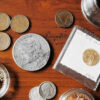- Empty cart.
- Continue Shopping
A Brief History of Coin Collecting

音声で聞く |
A Brief History of Coin Collecting
It is said that during the Great Depression, following the overwhelming Wall Street crash of 1929, the main ventures important to touchy examiners were artistic work, uncommon vehicles, and old coins. That guideline appeared to have won during each ensuing time of monetary market shakiness since the 1930s since the three classifications have would in general demonstrate their benefits again and again.
Scant gold and silver mint pieces are exceptional in the collectibles domain since they have both inborn worths dependent on their valuable metal substance and worth as recorded things. Gold and silver bullion has a dissolve esteem directed by worldwide monetary business sectors, however bars of valuable metal are not gained principally for their magnificence or extraordinariness. They are items.
An illustration of a gatherer top pick, this 1799 US $10 ‘Covered Bust’ Gold Eagle with Lady Liberty on the front-side and American Eagle with US Shield on the opposite was bought for $7,500 in addition to purchaser’s premium on April 20, 2013. Picture politeness of LiveAuctioneers Archive and Early American History Auctions
Individuals have stored coins for their bullion an incentive however long coins have been stamped. In any case, the assortment of coins for their creative worth was a later turn of events. Proof from the archeological and verifiable records of Ancient Rome and archaic Mesopotamia demonstrates that mint pieces were gathered and classified by researchers and state depositories.
It likewise appears to be plausible that singular residents gathered old, outlandish, or memorial coins as a reasonable, convenient type of craftsmanship. As per Suetonius in his De vita Caesarum (The Lives of the Twelve Caesars), written in the first century CE, the ruler Augustus in some cases introduced old and intriguing coins to companions and squires during celebrations and other extraordinary events.

A 1899 Chinese Kwangtung Empire example design dollar coin sold for $150,000 in Heritage Auctions’ June 22-24, 2016 closeout held in Hong Kong. Picture politeness of Heritage Auctions
Contemporary currency gathering and appreciation started during the Renaissance, around the fourteenth century. Since just the exceptionally rich could bear the cost of the pursuit, mint piece gathering became known as the “side interest of lords.” The Italian researcher and artist Petrarch is credited with being the pursuit’s first and most renowned fan. Taking cues from him, numerous European rulers, rulers, and other honorability kept assortments of antiquated coins. A portion of the eminent authorities were Pope Boniface VIII, Emperor Maximilian I of the Holy Roman Empire, Louis XIV of France, Ferdinand I, Henry IV of France, and Elector Joachim II of Brandenburg, who began the Berlin Coin Cabinet (Münzkabinett Berlin).

The very first US gold coin stamped, the ‘Brasher Doubloon,’ was struck in 1787 by a neighbor of George Washington. Legacy Auctions sold the coin for $4,584,500 in 2014. Picture politeness of Heritage Auctions
During the seventeenth and eighteenth hundreds of years, mint piece gathering stayed an aristocrat pursuit. Yet, during the purported Age of Enlightenment that cleared Europe during the eighteenth century, a more methodical way to deal with the collection and investigation of old currencies was embraced. Simultaneously, mint piece gathering was turning into a relaxation quest for the developing working class, anxious to demonstrate their abundance and complexity.
During the nineteenth and twentieth hundreds of years, the market for coins extended to incorporate old fashioned coins, yet in addition unfamiliar and extraordinary money. Mint piece shows, exchange affiliations, and administrative bodies arose during these many years and in 1962, the primary global show for currency authorities was mutually facilitated in Detroit, Michigan, by the American Numismatic Association and the Royal Canadian Numismatic Association. An expected 40,000 individuals joined in – a demonstration of the ubiquity of an interest once saved for simply the richest and most noble people.

The US Mint’s State Quarters Program gave a reasonable way to young people to enter the currency gathering interest. This model is the evidence for the 2001 North Carolina quarter, which portrays the Wright Brothers’ first trip at Kitty Hawk.
While it is hard to tell the number of individuals gather coins, unmistakably these days coins draw in devotees of each age and standing. Need evidence? The United States Mint has assessed that about 120 million Americans sought after the 50 States Quarters gave from 1999 through 2008. This measurement alone shows that as opposed to its elite beginnings, mint piece gathering has become maybe the most libertarian, everything being equal, with section level value focuses that even adolescents can bear.









